In case you missed the Ryzen 7000 Series news that’s been bombarding the techie scene, AMD’s Zen 4 processors have officially been released into the wild. Adopting new technologies and pushing beyond 5.0 GHz on boost speeds across multiple cores, these CPUs are part of AMD’s plans to release the fastest gaming processors on the market–at least for now.
Our initial impressions of the Ryzen 7 7700X and Ryzen 9 7900X were stellar, but they only told half of the Zen 4 story. Today, we get to take a closer look at the current bookends of the Ryzen 7000 Series – the Ryzen 5 7600X and Ryzen 9 7950X. Now that we have a more comprehensive picture of the whole line across both budget and premium CPUs, we can more accurately predict how Zen 4 will compete against Intel.
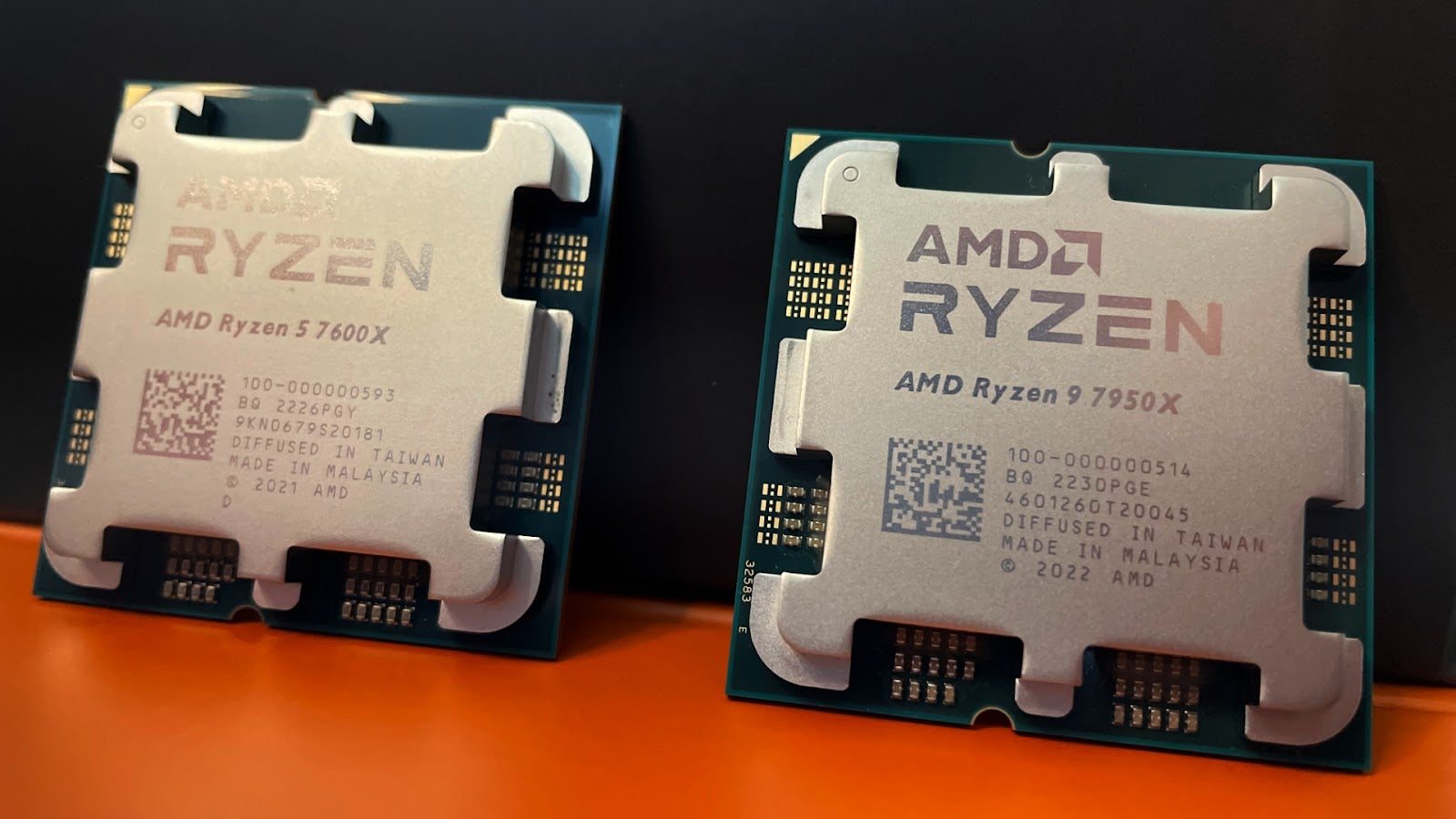
AMD Ryzen 5 7600X and Ryzen 9 7950X CPUs
What Is It?
AMD Ryzen 5 7600X and Ryzen 9 7950X: The bookends to AMD’s Ryzen 7000 Series
Price
$US299 ($415) (Ryzen 5 7600X) and $US699 ($970) (Ryzen 9 7950X)
Like
The 7950X offers unparalleled multi core, multi thread performance, The 7600X offers access to the Zen 4 platform at a modest entry fee, Gaming performance is consistently great across the Ryzen 7000 Series
Dislike
The 7600X is a budget option without budget motherboard support at launch, The new platform as a whole needs a bit more maturity, Thermals require reliable cooling
In this article, we will take a look at the performance of the Ryzen 5 7600X and Ryzen 9 7950X in productivity and gaming alongside the rest of the Ryzen 7000 Series. We’ll also investigate the thermal performance and energy draw, so that by the end, we can give you our best picture of which processor might be right for your use-case.
Let’s get started.
Recap: New Platform, New Processor Design, and a (Condensed) Overview

The socket is not the only redesign; AMD has integrated RDNA 2 cores into the Ryzen 7000 Series. These are among the first mainline Ryzen processors to release with an integrated graphics processing unit (iGPU). While we do not recommend users run their system off of an iGPU alone, they do come in handy for troubleshooting purposes. This isn’t new technology, but the addition of an iGPU is a welcome one, and helps keep these processors in line with the competition from Intel.
Speaking of older technology, unlike Intel’s Alder Lake (and forthcoming Raptor Lake CPUs), AMD has completely moved away from DDR4 on these chips to focus on current or up-and-coming technologies like DDR5 RAM and PCIe 5.0.
The adoption philosophy with PCIe 5.0 is, however, dependent on the motherboard’s chipset – and AM5 has four of those: X670E, X670, B650E, and B650. While each platform supports PCIe 5.0 storage, only the “E” variants will support a PCIe 5.0 graphics card slot.
As for other differences between the motherboards, the X670-series is intended for users looking for overclocking headroom and power delivery, while the forthcoming B-series promises access to the AM5 platform while keeping the budget-conscious in mind. This is an important detail to remember, especially as we talk about the 7600X.
Finally, AMD has also incorporated Extended Profile for Overclocking – or EXPO – into its DDR5 support. EXPO, much like Intel XMP, provides simple, one button overclocking for RAM speeds, timing, and voltage, which helps a chip to perform at an optimised level.
For a more comprehensive overview of the platform, read our review of the 7700X and 7900X.
Ryzen 5 7600X and Ryzen 9 7950X Specs
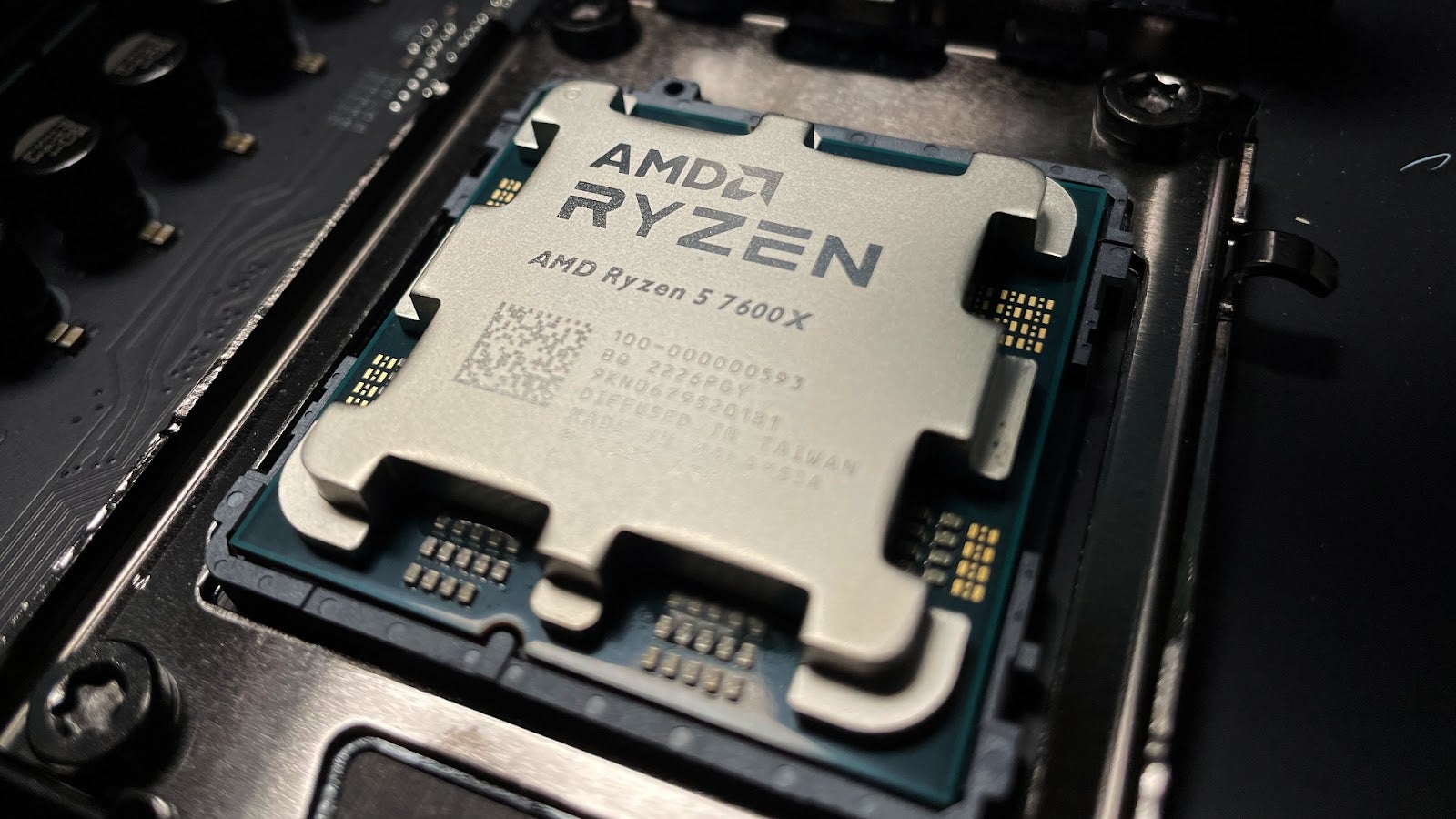
Now that we’ve had a refresher on what’s new with the AM5 platform, let’s talk about the CPUs we’ll be highlighting, some basic differences between them and their predecessors, and where they fall within the product stack.
Beginning with AMD’s entry-level CPU, the Ryzen 5 remains a six-core, twelve-thread (6C/12T) offering. The 7600X received a healthy 1.0 GHz bump in base speed over the 5600X’s 3.7 GHz base clock, while the max boost clock puts the 7600X at 5.3 GHz. This isn’t a whole lot of headroom compared to the previous generation, but I can say through observation that it definitely hit or exceeded – and held – 5.3 GHz on multiple cores throughout our testing. This is, of course, helped out by a bump in thermal design power (TDP) from 65 W to 105 W.
On the other end of the spectrum, we have AMD’s newest flagship CPU, the Ryzen 9 7950X. This 16C/32T monstrosity shares similar base clock speeds with the 7700X at 4.7 GHz – 1.3 GHz faster than its predecessor, the 5950X – and boasts a boost clock of 5.7 GHz. For context, the max boost of the 7950X takes a 900 MHz lead from its ancestral next of kin. Like the rest of the Zen 4 line up, we do see the 7950X raise generational TDP from 105 W to 170 W.
As mentioned in my previous article, the Ryzen 7000 Series as a whole sees this TDP increase as well as an increase in L2 cache size. On each CPU, we see L2 cache doubled over the previous generation.
Performance, Power, and A More Complete Picture of Zen 4 Performance
Charts and numbers tell very specific stories, so we tried to keep our methodology as simple as possible in order to give a concise picture of the performance that the average user might expect to get out of the Ryzen 5 7600X and the Ryzen 9 7950X. Like in our previous tests, the numbers you are about to see are out-of-the-box performance – no overclocking and no settings tweaks. The only feature that we enabled was an AMD EXPO profile for low memory latency and speed.
Here is the hardware we used to collect our data from the Ryzen 7000 Series CPUs: ASRock X670E Taichi motherboard, NVIDIA RTX 3090 Founders Edition GPU, 32 GB G.Skill Trident Z5 NEO DDR5-6000 RAM, 1TB WD_Black SN770 M.2 NVMe SSD, NZXT C1000 Gold 1000W PSU, NZXT Kraken Z73 360mm all-in-one liquid cooler with three 120mm fans, and an NZXT H7 Elite mid-tower PC case equipped with four 140mm fans.
As with our previous review, we are also including test data collected from the Core i9-12900K and Core i5-12600K, as well as AMD’s Ryzen 9 5950X. This data was collected for Gizmodo’s reviews of Intel’s 12th Generation CPUs and AMD’s flagship from AMD’s Ryzen 5000 Series by Joanna Nelius and Sarah Jacobsson Purewal, respectively. As with any test, your mileage may vary. It is important to keep in mind while drawing comparisons between their data and mine that our testing environments were different, as was some of the equipment used for these tests.
Now, on with the show!
Benchmark Breakdown: Productivity
For our productivity tests, we ran a suite of software benchmarks to highlight single- and multi thread performance in scenarios that test how each CPU performs under various computational loads.

In Geekbench 5, we see in single thread tasks–such as web navigation, PDF rendering, image and text compression, and machine learning–that the Ryzen 5 7600X take a 26.8% leap in performance ahead of the Ryzen 9 5950X while overtaking the Core i9-12900K by a modest 10.9%! The Ryzen 9 7950X takes a 15.8% lead against the 12900K while putting up an increase of 32.4% against the 5950X.
It is worthwhile to note that there is only a 4.4% difference in single core performance between the Ryzen 5 7600X and the Ryzen 9 7950X. Keep that in mind.
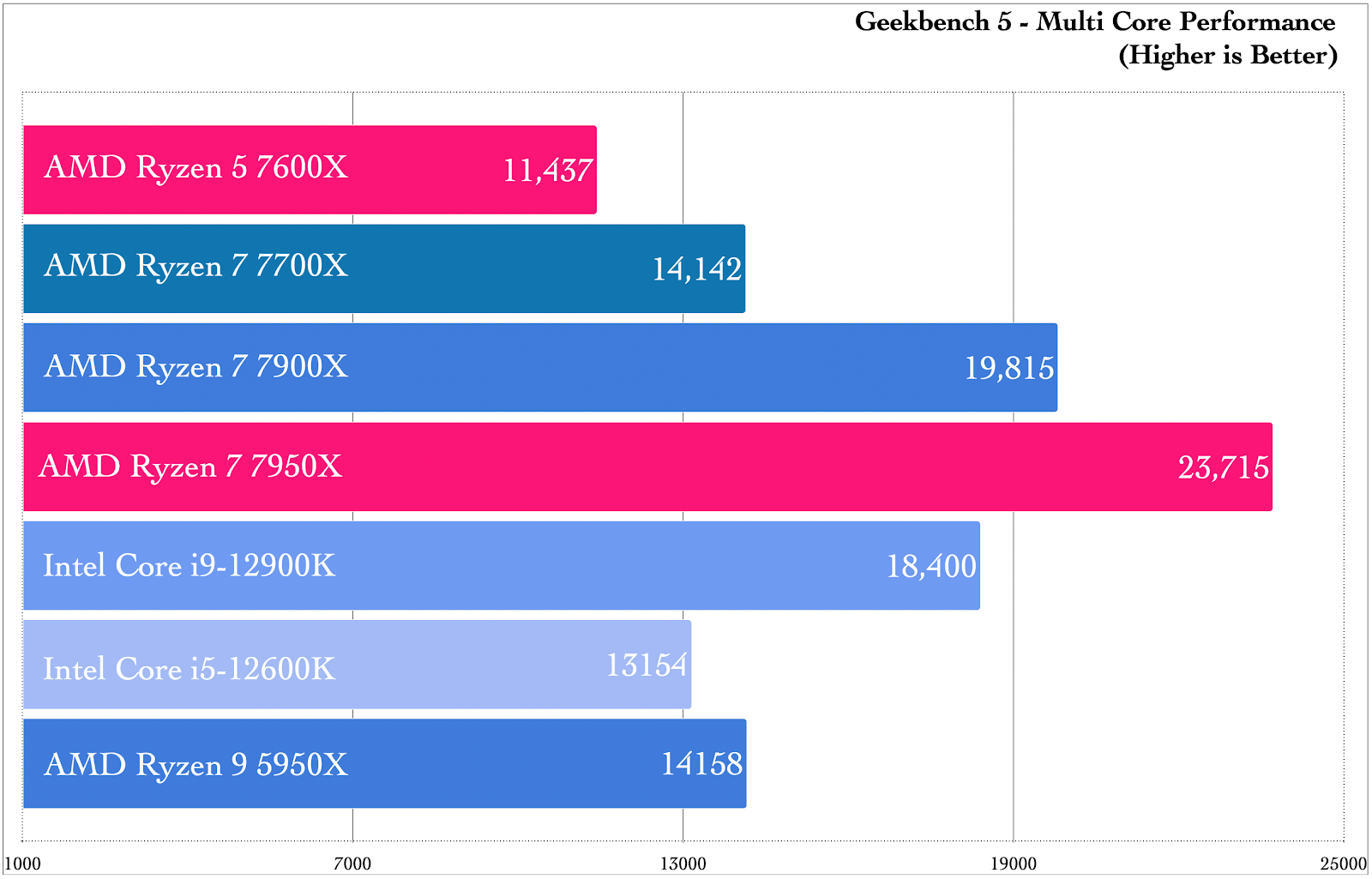
In the Geekbench 5 multi core testing, we see the true dominance of the 7950X. Leading the 12900K by a margin of 28.8%, the 7950X makes a substantial claim to the multi core performance throne. Meanwhile, the 7600X does the opposite as it falls -19% against the 5950X and trails the 10-core Core i5-12600K. This test revealed a trend that we would continue to see with the Ryzen 5 7600X: it does not shine in multi core, multi threaded applications.
In Handbrake, while converting a 4K video file to a 1080p30 format, the 7600X was a whole 33 seconds slower than the 12600K, but on the other side of the spectrum, the 7950X shaved 13 seconds off of the 12900K’s best time. While it is hard to make a direct comparison between the two architectures, the 7950X is putting more threads to work than the 12900K for that ~6% gain in time.
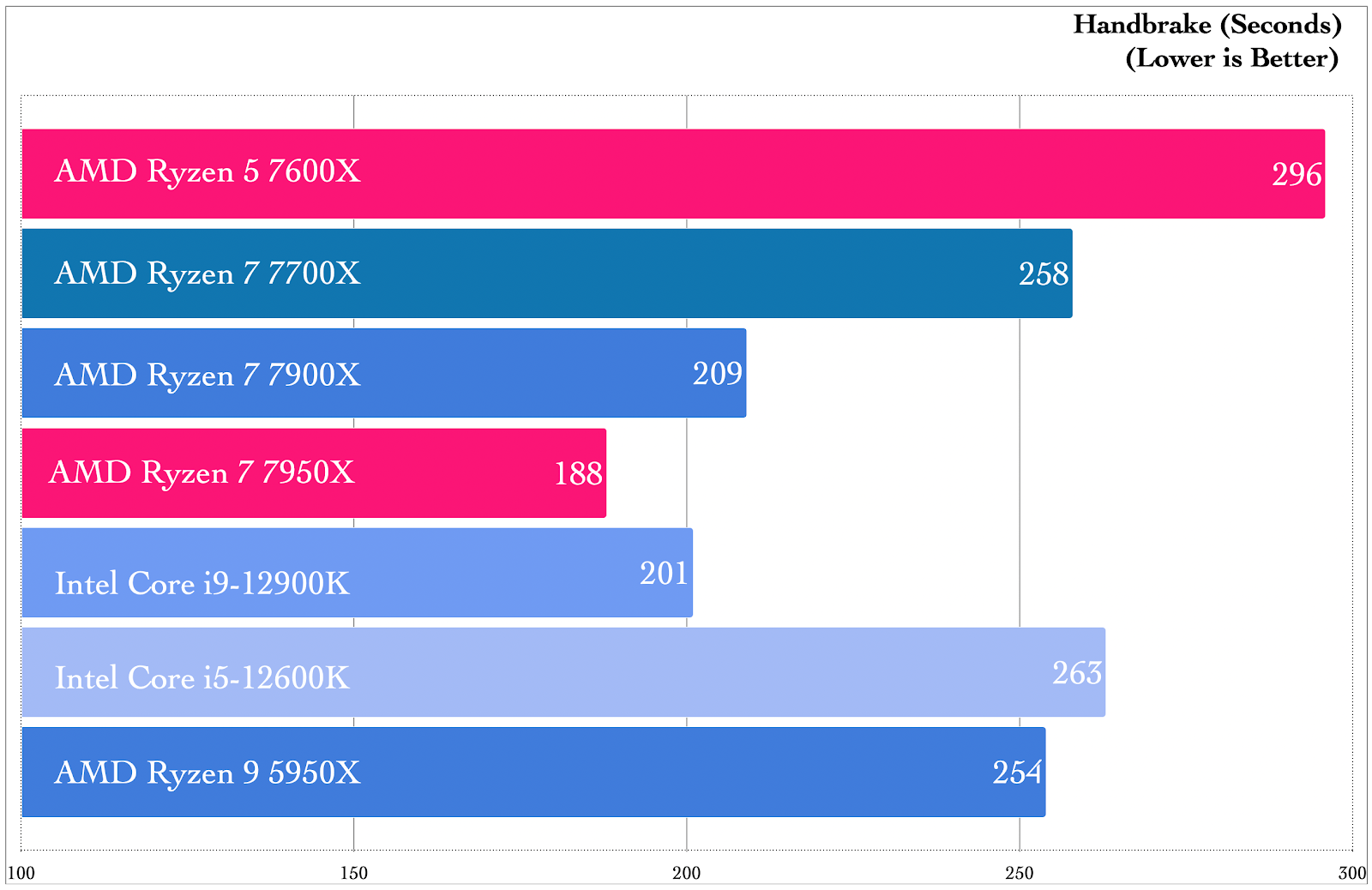
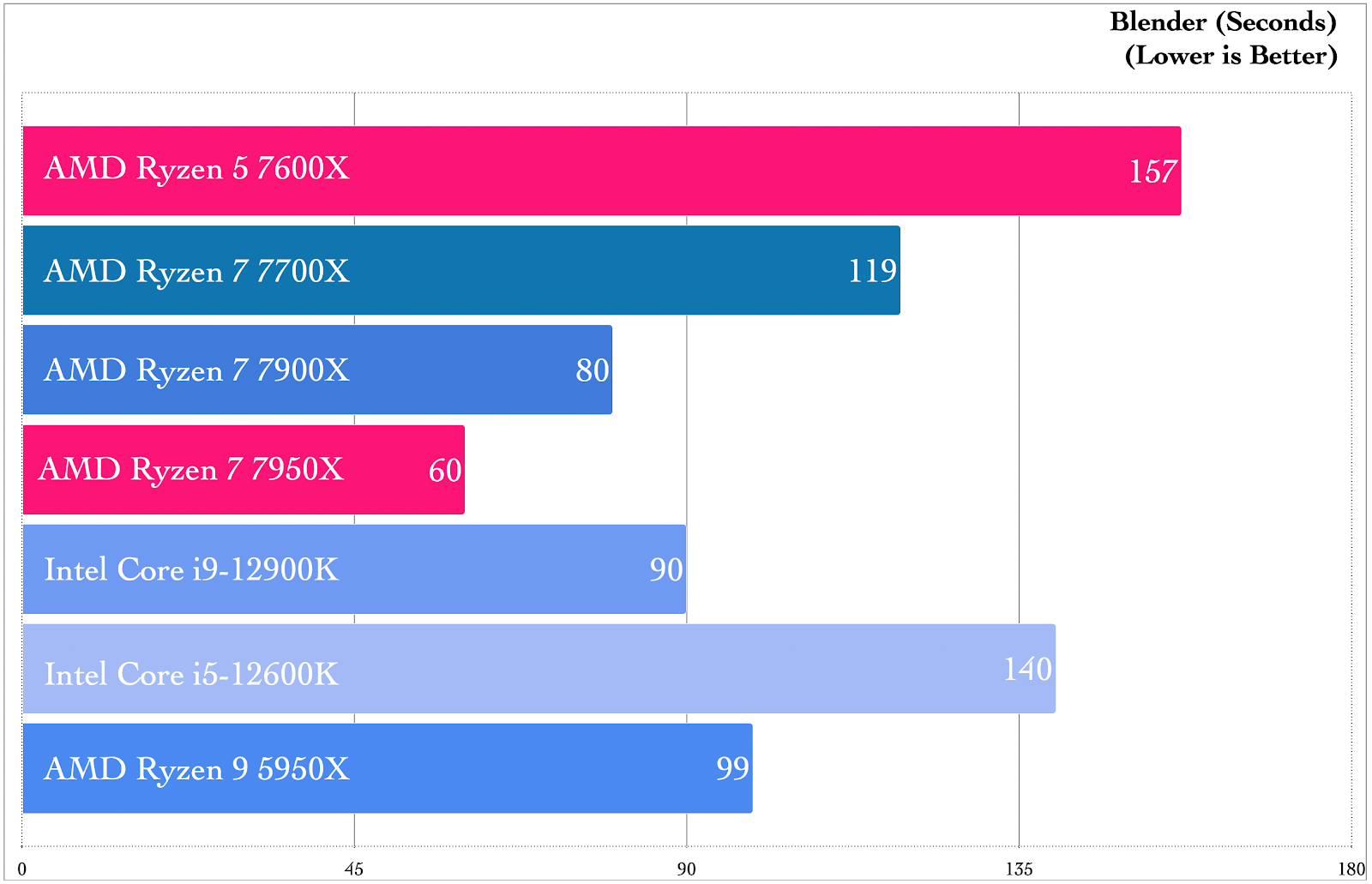
In Blender, we saw that delta widen. Rendering everyone’s favourite shiny, red BMW, the 7950X rendered the image in 60 seconds flat – 20 seconds faster than the 7900X and 30 second faster than 12900K. The story of the Ryzen 5, however, is the same: it lagged behind the 12600K by a small margin – but only by 17 seconds.
Benchmark Breakdown: Gaming
To remove as much GPU dependency as possible, we ran all of our gaming tests at 1080p to get the clearest picture of the CPU’s impact on performance. These tests were taken from games that had synthetic benchmarks, allowing for repeatable, consistent data.
In our review for the rest of the Zen 4 launch lineup, we mentioned that these benchmarks revealed an oddly predictable trend: the performance was eerily similar–and that trend continued here.
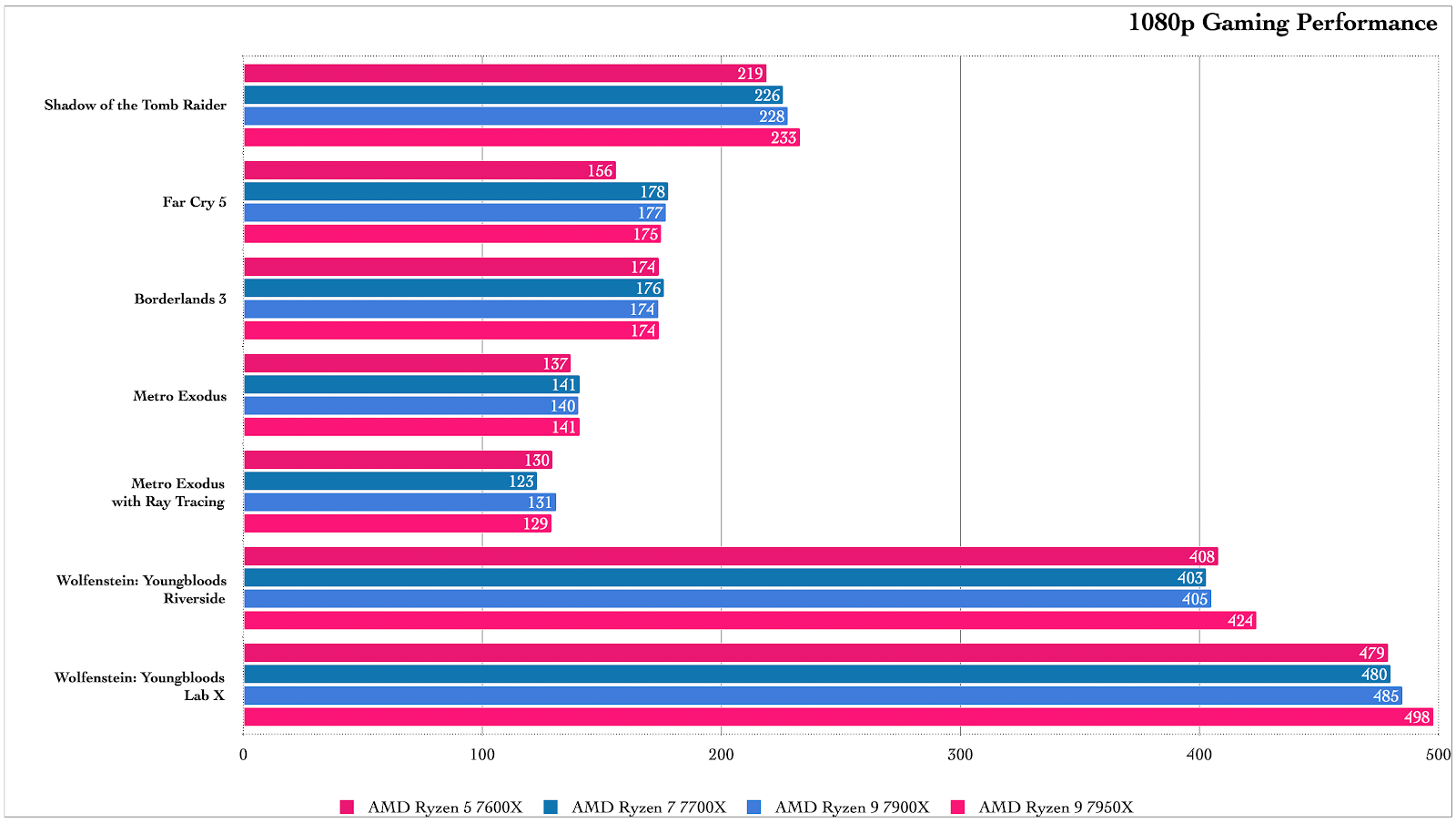
After multiple benchmark runs, checks for background tasks or other performance drains, the data speaks pretty clearly: gaming performance across Zen 4 is very close across the series – almost to the point of being negligibly different.
Keep in mind, these numbers are not bad numbers; each of the Ryzen 7000 CPUs ran our benchmarks at or beyond 1080p120 in our gaming tests without any performance stuttering, thermal throttling, or the benefit of performance boosting features like AMD’s FidelityFX Super Resolution (FSR) or NVIDIA’s Deep Learning Super Sampling (DLSS). These results, specifically for the 7600X, are pretty fantastic for the consumer looking for high end performance without having a high end budget. But we will have to talk about the implications of this information in a moment.
Energy Efficiency and Thermal Performance
AMD’s goal with Zen 4 was to create a platform that leads the industry in performance and energy efficiency. Arguably, the company got the performance part down, but at a cost. As noted earlier, each CPU in the Ryzen 7000 Series line up has been saddled with an increase in overall TDP. This has pushed performance to new heights across the board, but it comes at the cost of both power and heat – and that is part of AMD’s strategy.
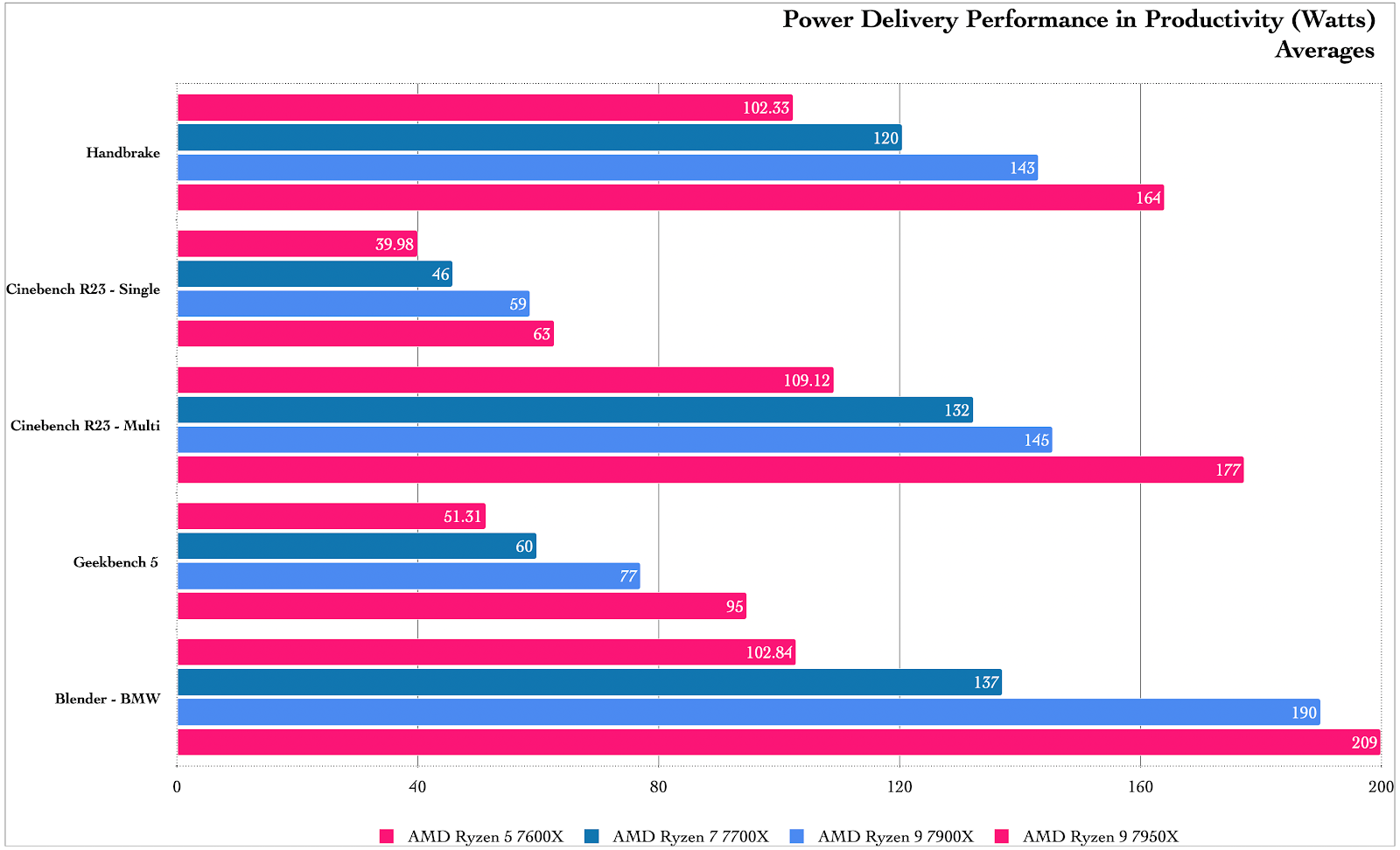
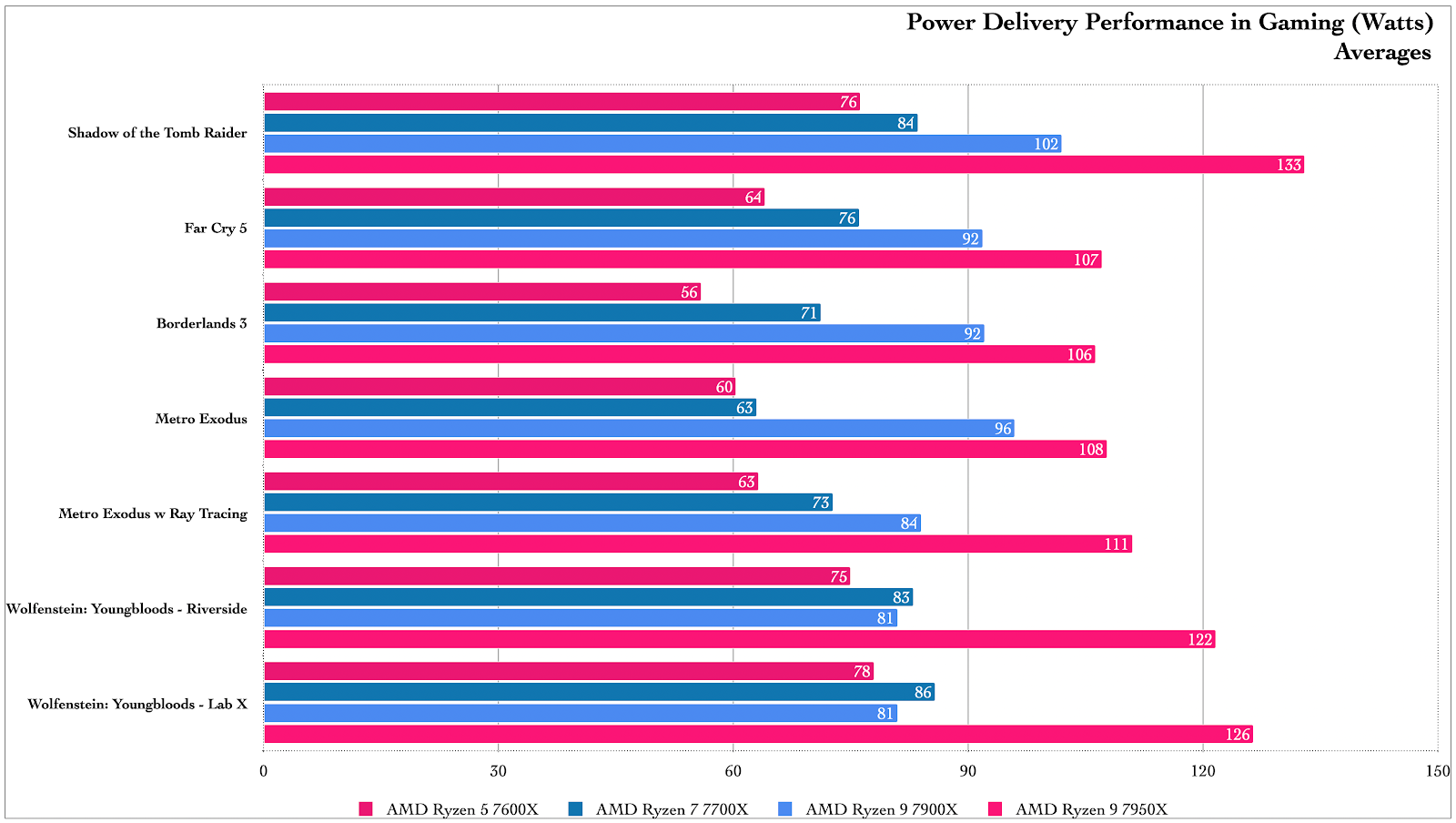
In most of our tests, we saw initial spikes in both power and temperatures on the front end of our benchmarks. With a Tjmax – thermal junction maximum, not America’s favourite discount outlet – of 95 degrees Celsius, our tests saw the CPUs initially slammed with power and heat, but they leveled out quickly. According to AMD, these chips were designed to take advantage of the power delivery of the Socket AM5’s LGA layout. Remember, that was the push to move to a new socket platform.
For context, we ran all of these tests using NZXT’s Z73 360mm all-in-one liquid cooler. The pump motor was set to performance mode, but all of the case fans were set to silent. This meant that the pump would live at about 70% operational capacity, then start ramping up to 100% if the CPU temperatures crossed over 55 C. In silent mode, fans were set to operate in stages. Fans would operate at 40% capacity until 65 C, step up to 70% until 85 C, then engage at 100% at 90 C until temperatures came down.
In productivity tasks where multiple cores and threads are at work, we saw the 7600X draw a significant amount of power compared to the performance that it was getting. In Blender, for example, the 7600X drew 102.84 W compared to the 7950X’s 209 W. While the 7950X drew more power overall, it performed twice as fast. Obviously, we’re talking about powering more cores versus fewer, but a point can be made that efficiency in these settings is not the 7600X’s strongest attribute.
Single core operations, however, are a completely different story. In settings like Cinebench R23’s single core benchmark and in gaming benchmarks, the Ryzen 5 7600X keeps in step with the rest of the Ryzen 7000 family in performance, but drew 23 W less than the 7950X in Cinebench alone. In our gaming benchmarks, where frames-per-second were within a slim margin, the 7600X continued its modest appetite for watts.
Thermal performance told a similar story. In most gaming situations, the 7600X stayed marginally cooler than the rest of the pack while the 7950X ran a few degrees hotter. In some cases, the difference from the bottom of the stack to the top was as little as ~3 C and as much as 15 C!
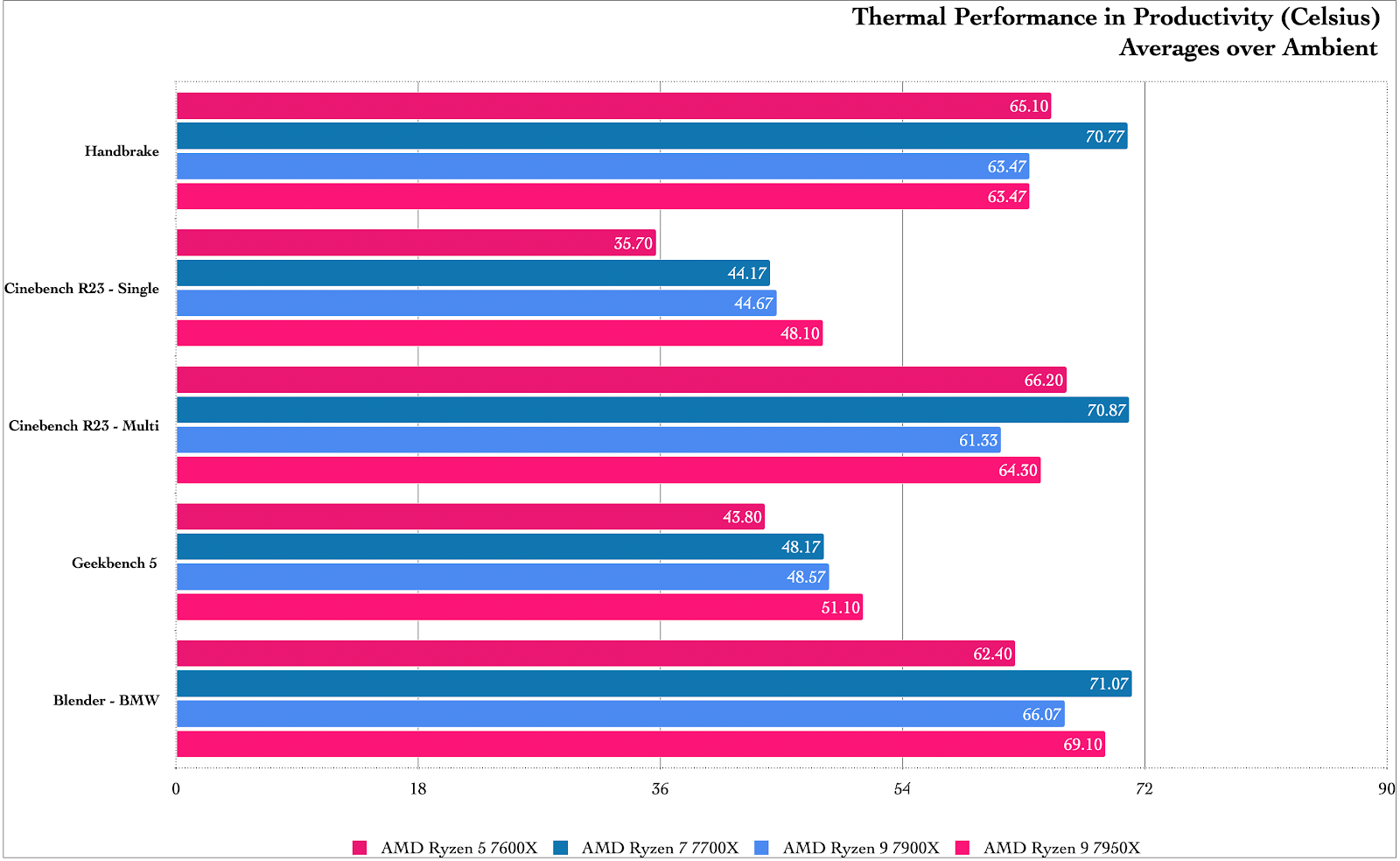
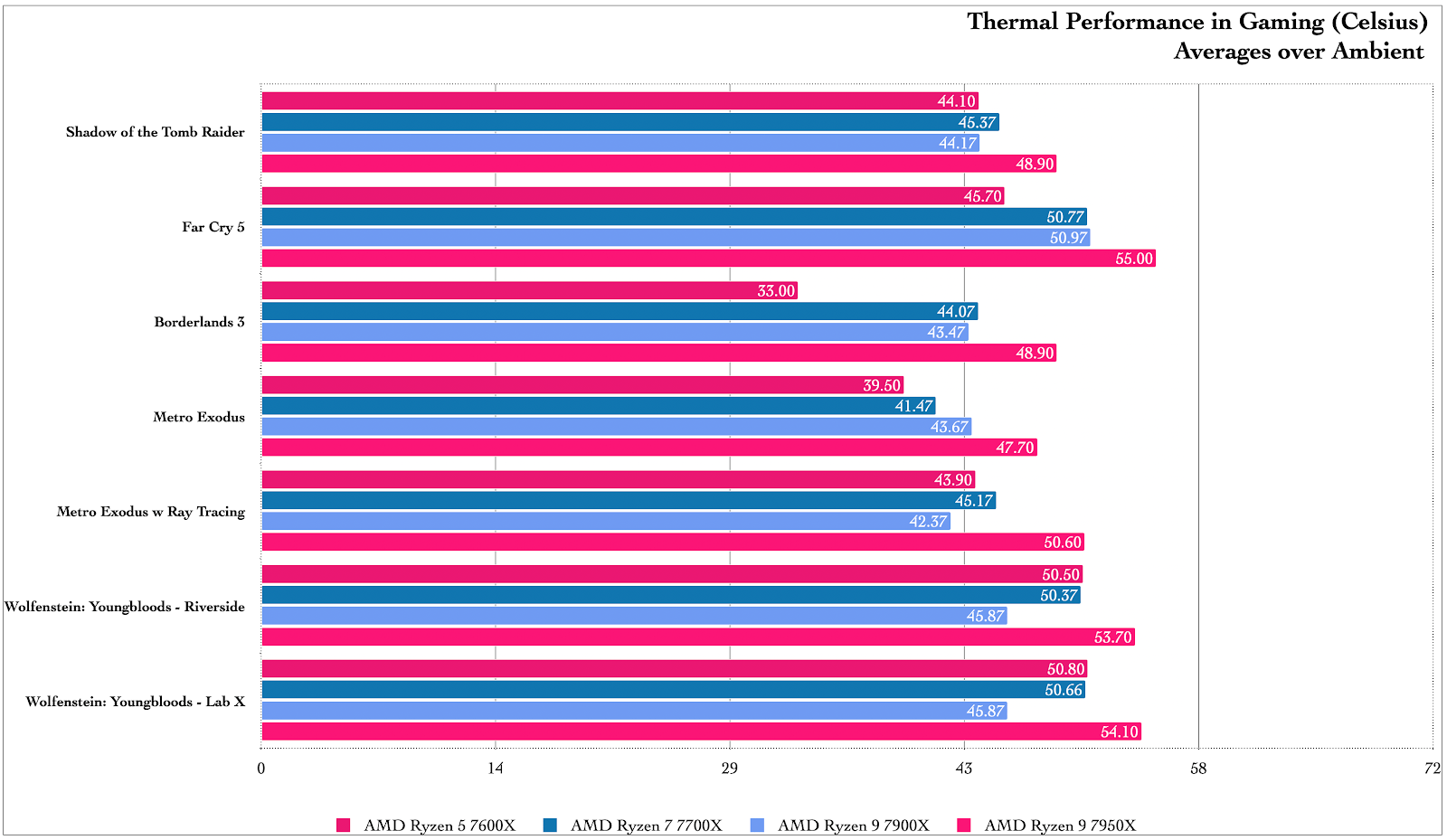
Zen 4 is designed to take the heat, but the real story of daily use is in between our productive results and the gaming benchmarks. The productivity tests are meant to put stress on a system to test its limits while the gaming benchmarks are rather short-lived. On average use, the Ryzen 9 7950X hovered around 45 C over ambient temperatures (23.3 C or 74 F).
With all of this in mind, here is the Zen 4 story as it relates to performance, efficiency, and thermals: it’s going to run hotter and draw more power than the previous generation, but it’s going to perform well. Just make sure you have a beefy cooler for those beefy cores!
So, Just How “Zen” Should You Get… And When?
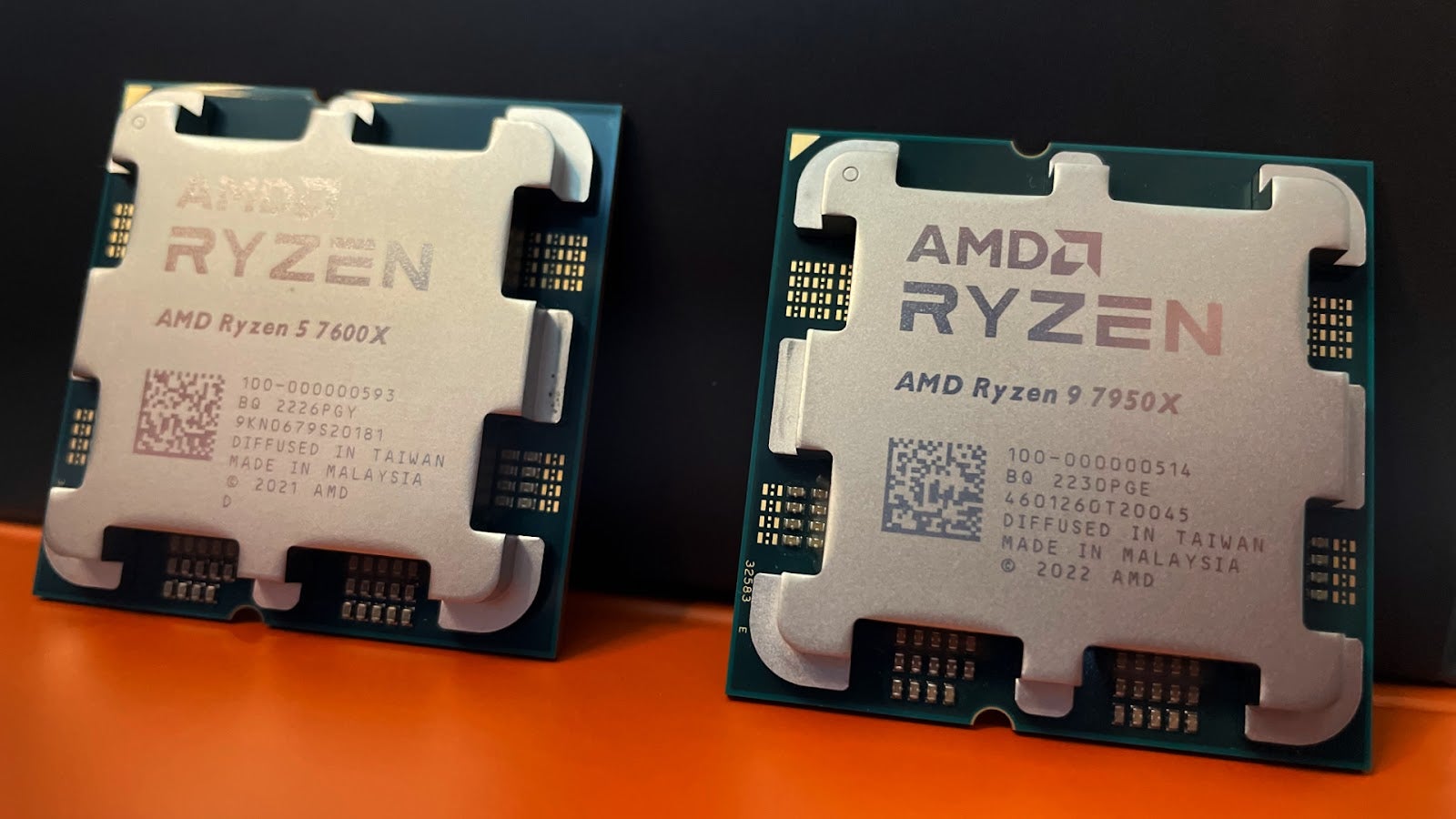
Now that we have a more comprehensive picture of the Zen 4 line up, I imagine that someone wants to know which one to buy. Lets begin with the Ryzen 5 7600X.
Without attributing motivation or marketing tactics, the 7600X feels like it was set up to fail at launch. The Ryzen 5 7600X is solid in gaming performance, keeping in close step with the other CPUs in the series while staying the low power draw leader amongst the pack. However, cost is a prohibiting factor. While the B650E and B650 motherboards have officially launched, the average price for a standard ATX-sized motherboard is still over $200 USD ($278). This is a shame, because the Ryzen 5 7600X is a great CPU for someone looking for pure gaming performance in a budget build. Without budget options in motherboards or lower cost DDR5 to pair it with, my advice for budget builders looking at the 7600X is this: wait.
If you must have a Zen 4 processor, wait until the B650 motherboards and the CPU come down a bit in pricing. However, if you have cash burning a hole in your pocket this very instant and you want an AMD build right now, here is my advice: a Ryzen 7 5800X is roughly the same price as the 7600X’s $US299 ($415). Great DDR4 kits can be found at a fraction of the price of DDR5 and solid X570 or B550 motherboards are incredibly accessible. Getting better components that are slightly older is a legitimate way to make your dollars work harder for you when it comes to PC building. For now, the Ryzen 5 7600X does not fit its budget positioning.
In the case of the Ryzen 9 7900X, this CPU shows up to work for the gamer that regularly utilises their PC for creative tasks like video production, live streaming, or animation. While it is not at the top of the stack, it is still $150 USD ($208) less than the Ryzen 9 7950X. Now, $549 USD ($762) is no small amount, especially when looking at all of the other expenses that will go along with this purchase. However, if you are looking for an upgrade from an older platform, time is money, friend; any of either saved means more for other ventures.
If that extra $150 USD ($208) for a CPU is not a big deal for you, the AMD Ryzen 9 7950X is currently unparalleled in its power and performance in multi core, multi thread tasks. This prosumer grade CPU demolished every task we threw at it while offering great frame rates in gaming as well. While it is extremely power hungry and not much is gained in gaming performance over the rest of the series, the raw computational power of this CPU is ridiculous.
And, in that last sentence, we find the biggest twist of the Zen 4 story.
When looking across the series, specifically at gaming performance, Zen 4 is consistent. There are a few incremental bumps between each CPU, but they are marginal at best in many of the single core, single thread applications we tested, including gaming. To be more blunt, there is a $US400 ($555) delta between the 7600X and the 7950X that does not net a significant enough increase in performance on Zen 4 to matter unless you are after multi core capabilities. And in most cases, the 5600X provided similar frame rates at a fraction of the power, heat, and price.
And this is where we come back to the Ryzen 7 7700X.
You may have noticed that I left the Ryzen 7 7700X out of the above list–that was intentional. Of the Ryzen 7000 Series, the 8C/16T Ryzen 7 7700X finds itself in a rather appealing place for the gamer that dabbles in lighter creative tasks. The performance and value of the CPU versus a competition leader like the 12900K are comparatively astounding. While the entire Ryzen 7000 Series is incredible, the 7700X is the CPU I have talked the most about and recommended since launch.
To bring the conversation back to the 7950X and the 7600X, both CPUs are tailored to two incredibly different types of users while providing access to modern technologies like PCIe 5.0 and DDR5 at every tier of CPU.
Once we see more budget-friendly options in RAM and motherboards to pair with the 7600X, it will be an extremely appealing choice for gamers who purely want to game. But, on the other end of the spectrum, if you are a prosumer looking to ascend in performance, the Ryzen 9 7950X may just be what you have been searching for. Just make sure you have the power supply to support it and whatever monolithic GPU you plan to pair it with!
With powerful Zen 4 cores at the heart of the entire Ryzen 7000 Series, AMD has unleashed a new era for the Ryzen family. Let’s just hope it can wrangle the RAM training sometime soon.
The product discussed in this article was provided by the manufacturer for the purposes of review.
